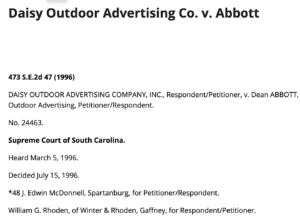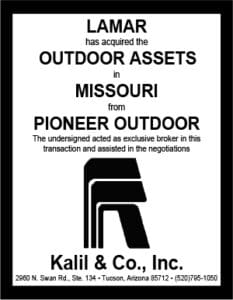 A pattern of anticompetitive behavior may backfire on you. That’s the lesson of Daisy Outdoor Advertising versus Abbott Company Outdoor Advertising.
A pattern of anticompetitive behavior may backfire on you. That’s the lesson of Daisy Outdoor Advertising versus Abbott Company Outdoor Advertising.
Here are the facts.
- Daisy Outdoor erected a legal billboard on real estate property it owned in Gaffney, South Carolina. In addition to the billboard the property included a building which was leased to a radio station.
- Abbott Outdoor erected a legal billboard on adjacent property which it leased to Clarkson Industrial Movers.
- Daisy erected a billboard beside its building advertising the radio station. The sign blocked Abbott’s billboard and violated state law. When Daisy was informed the sign was illegal, it replaced the illegal sign with an unregulated “for sale” sign advertising the property on which the sign was located.
- Abbott had to move the Clarkson ad to another billboard.
- Abbott built a two sided billboard at another site and leased one side to Hamricks of Gaffney, an auto dealer. Daisy asked to sublease the other side of the billboard from Abbott and Abbott declined.
- Daisy erected an unregulated “for sale” sign on property it owned adjacent to Abbott’s billboard in manner which blocked the auto dealer ad.
- Abbott lost the auto dealer’s business and sued Daisy claiming intentional interference with contract rights and unfair competition.
- A trial judge ruled in favor of Abbott and awarded damages equal to treble the amount of the auto dealer contract because Daisy’s actions were willful. In July 1996 the Supreme Court of South Carolina upheld the verdict arguing that Daisy’s actions had the potential for repetition and harmed the public interest. The Court said: “The action complained of – Daisy’s intentionally blocking Abbott’s signs was repeated (Daisy blocked the Clarkson sign; later, it blocked the Hamrick’s sign). Further more, Hamrick’s, at least, was injured by Daisy’s actions…As a member of the public, albeit a commercial member, Hamrick’s was entitled to protection from Daisy’s unfair and deceptive acts.”
Billboard Insider’s take: Be careful of a pattern of behavior which can be construed as anticompetitive. As Auric Goldfinger says to James Bond in the novel Goldfinger: Mr Bond, they have a saying in Chicago: “Once is happenstance. Twice is coincidence. The third time it’s enemy action.”
[wpforms id=”9787″]
Paid Advertisement

















